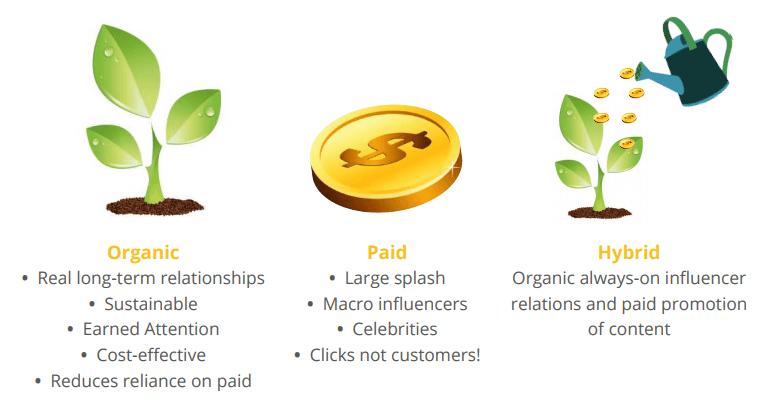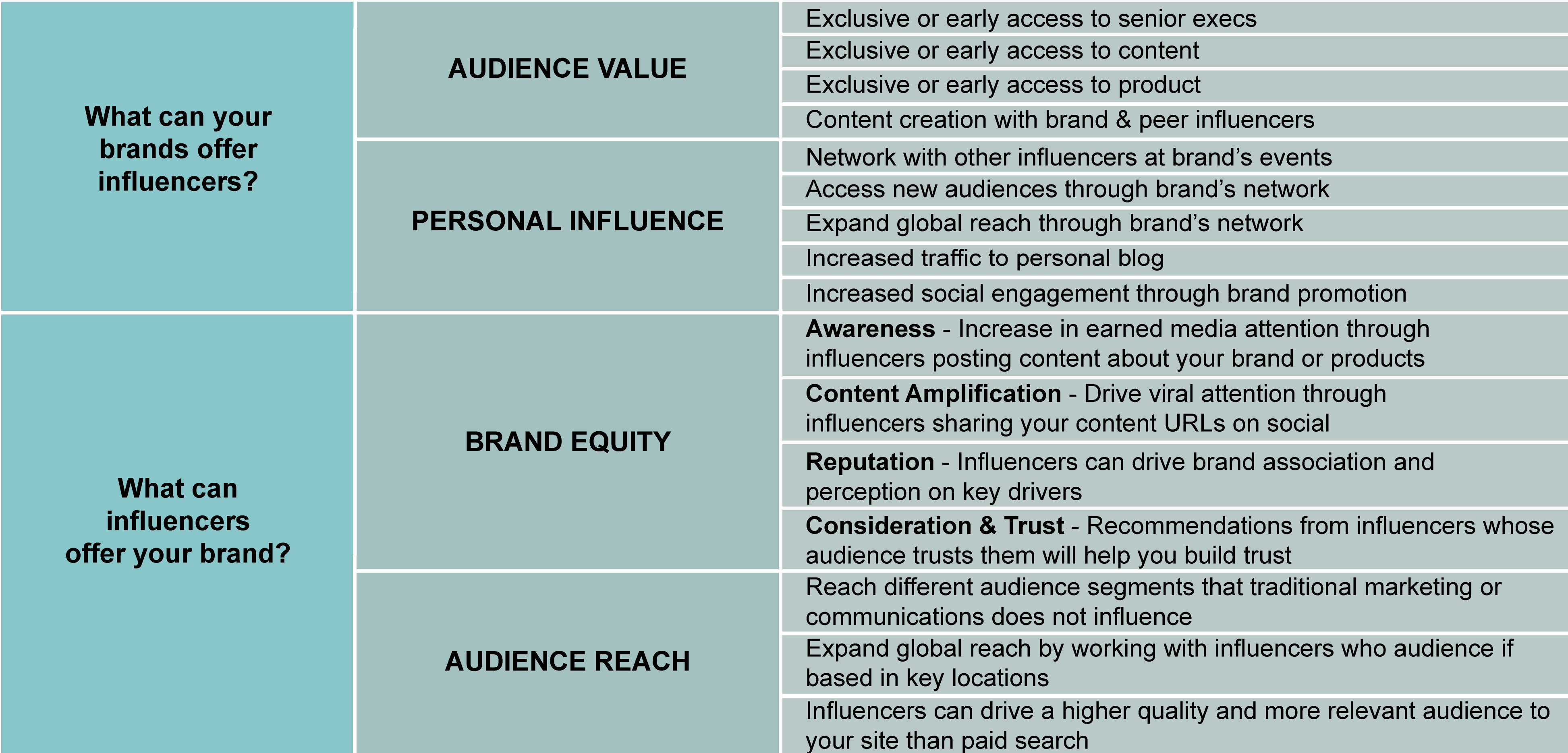Getting influencer marketing right all lies on nailing your influencer engagement. We know where our target audience are being influenced, so now it’s time to start engaging with influencers on these channels. This comes down to fostering a PR culture of building 1-to-1 relationships with influencers, but with a marketing mindset of scaling this to influence your target audience as a whole.
To ensure you’re in the right mindset, ask yourself the following two questions:
- Would you approach someone you’re unfamiliar with and outright ask them to be your friend?
- Would you pay them to not only be your friend, but to say nice things about you, even though they barely know you?
I’m going to go on the fair assumption that you answered NO to both of those questions. Well – the exact same goes for working with influencers.
How can you expect an influencer to represent and advocate your brand in a genuine, authentic way, evoking trust in your target audience, if you’re building your relationships on false pretences and hollow foundations? The reason influencer marketing works, is that consumers have much greater trust in individuals than they do brands; they trust humble opinions from their peers more than they do advertising. Paying influencers to say what you want them to say is fundamentally no different than advertising – the only difference is the channel you’re using to amplify your message. Your consumers are the key to your success; it is in your interest to value them, not to pull the wool over their eyes.
As humans we hold an innate scepticism – as children we were told not to talk to strangers and as adults we ignore fellow passengers on our commute. Building trust and relationships with influencers takes time, much the same as real life relationships. Influencers are human beings with emotions and interests outside of their work- Joe Martin, Head of Social Analytics and Evangelist at Adobe touches on how their approach is having email and Twitter conversations that go beyond their work with Adobe- it’s a personal exchange with both give and take.
However, how can you nail your influencer engagement without changing everything that you do? We’re going to take you through the motions of how you can create an effective influencer engagement strategy.
Organic, paid, or both?
The question on everyone’s lips is: ‘should I pay my influencers?’. To answer this honestly, it depends entirely on your brand, the nature of your industry and what you’re wanting to achieve. Below is an overview of when organic, paid and hybrid approaches are most appropriate:

Organic
Influencer engagement with the end goal of building authentic relationships and fostering brand advocacy. Engaging with and sharing influencers’ content, with the intention of co-creating content together that will add value to: 1) your brand, 2) yours/their target audience 3) the influencer. This is a much more cost-effective, longer term, sustainable approach.
E.g. A human rights charity building a relationship with a human rights advocate, by sharing and engaging with their content. This relationship matures to the point where both parties are keen to work together and co-create a piece of content, combining their passions to make a change.
Paid
Macro and celebrity influencers tend to be the influencers of choice under this category. Brands pay influencers with large followings as a means of gaining quick, short term exposure to their audiences. This can work and be appropriate (mostly in B2C), but authenticity and trust in both your brand and the influencer may be questioned, if the alignment isn’t there or the influencer’s opinion doesn’t seem genuine.
E.g. A fashion brand gifting and/or paying an Instagram influencer to post pictures of them wearing their clothes with #ad or #spon.
Hybrid
A combination of the above two approaches. Long term focus of engaging and building relationships with well aligned influencers, with some financial compensation here and there to merely pay for the larger influencers’ time. This could be paying for them to guest blog on your site, host a webinar or give a speech at your event. Tim Williams, Onalytica’s CEO says “pay for influencers’ time, not their opinion.”
E.g. A B2B finance brand building a relationship with an influencer, and down the line paying the influencer to write a white paper.
“Marketers feel like they have to pay for influencers’ time but they don’t.”
Tim McLoughlin, Head of Social Media, Hotels.com
” Of course, the most commonly thought of type of value is money. However, carefully considering how your business can also provide audience value and personal influence as a way to engage will make attracting influencers infinitely easier.”
Owain Williams, Influencer Marketing Blogger, ojawilliams.com
Create value for your influencers
Ultimately, the influencers worth working with are going to have their pick of the bunch on brands they choose to work with – your offer is just one of many. Therefore, it is important to understand the value your influencer seeks to gain by working with your brand:
- Audience value (creating exciting content, providing new knowledge and educational content for their audience)
- Personal influence (opportunities to expand their network, drive awareness of their brand, maximum brand/influencer relevancy)
- Money (from covering expenses to paying for their time to produce content or focus on promoting your brand)
It is important to understand your influencers’ wants and needs so that you’re able to influence them to communicate your messages to your target audience.
” Influencers will decide on whether to engage with you based on whether you have interacted with their content, recent posts, social infleunce and power of your brand.”
Jason Miller, Global Content Marketing, LinkedIn
Integrate your existing skill sets
There’s no need to reinvent the wheel here – look at your internal teams and the skills they have to offer:
- Insights & Analytics to understand the influencer community and select engagement targets
- PR Mentality to build 1-to-1 relationships
- Social Media Strategy to understand what channels and tactics will work best
- Social Media Presence to have credible outreach
- Content Planning and Design to create engaging and inspiring content
- Content Promotion to ensure your content is reaching the right audience and driving business outcomes
- SEO to ensure your content is helping you shoot up the search rankings organically through influencers sharing your content
Influencer Generated Content
Owain Williams highlights that many brands work tirelessly and spend significant sums of money in order to get influencers to share and engage with their content. Yet a much easier way to engage and attract to your content is to physically include them in the process of creating it.
If you’ve identified the most appropriate influencers for you brand, then you should be able to work with influencers and grant them some free reign with content creation. Do not make the mistake of trying to heavily brief and control your influencer, as this risks authenticity.
While continuity of brand messaging and tone of voice is of course important, influencers are influential because they’re experts, you should only be working with them if you think they have something to bring to the table – so loosen the puppet strings and let them bring it!
Influencer generated content opens up opportunities for you to provide your target audience with more diverse content- this also aids your SEO strategy. Move away from 100% branded content, amplified with paid for ads. Influencers don’t just come with an abundance of knowledge, but another audience, too. Neal Schaffer highlights in his post entitled: How to Supercharge Engagement with Your Content, influencer generated content works to both build greater trust with your audience by sharing great content, while building rapport with the influencer.
“With influencers you may lose control of your message. But what you lose in control, you gain in trust.”
Tim Hughes, Social Selling Influencer & C-founder of Digital Leadership Associates
The rules of engagement
Here is an example plan that you can adhere to:
- INTRODUCTION – engage with and introduce topical influencers to your brand
- RECOGNITION – recognise and reference your influencers’ relevant work and content within your own content
- INVITATION – invite your influencers to contribute to your content
- CONTENT GENERATION – design a modular approach of high value content such as eBooks, blog posts, tweets, motion videos or infographics
- EVENT – invite your influencers to a round-table event and create content at the event such as interviews or panel discussions
- CONTENT GENERATION – roll out even more high value content generated from the event
- NURTURE – continue to develop relationships as part of an always-on relationship management program. If you have positioned your relationship with an influencer as a genuinely mutual value exchange, working together to co-create a piece of content should be a logical extension of this process.
 “Connect influencers whose common denominator is your brand. The best influencers not only drive 3rd party endorsement but they understand your brand strategy and roadmap.”
“Connect influencers whose common denominator is your brand. The best influencers not only drive 3rd party endorsement but they understand your brand strategy and roadmap.”
Konnie Alex-Brown – Head of Influencer Relations, Dell EMC
To download the full white paper, click the button below.

DOWNLOAD NOW!
TAGS
DEFINITIVE PRACTICAL GUIDE TO INFLUENCER RELATIONSHIP MANAGEMENT
Download this free white paper including guidance and frameworks, that takes you through the whole influencer marketing process, in a practical and actionable way.





